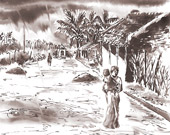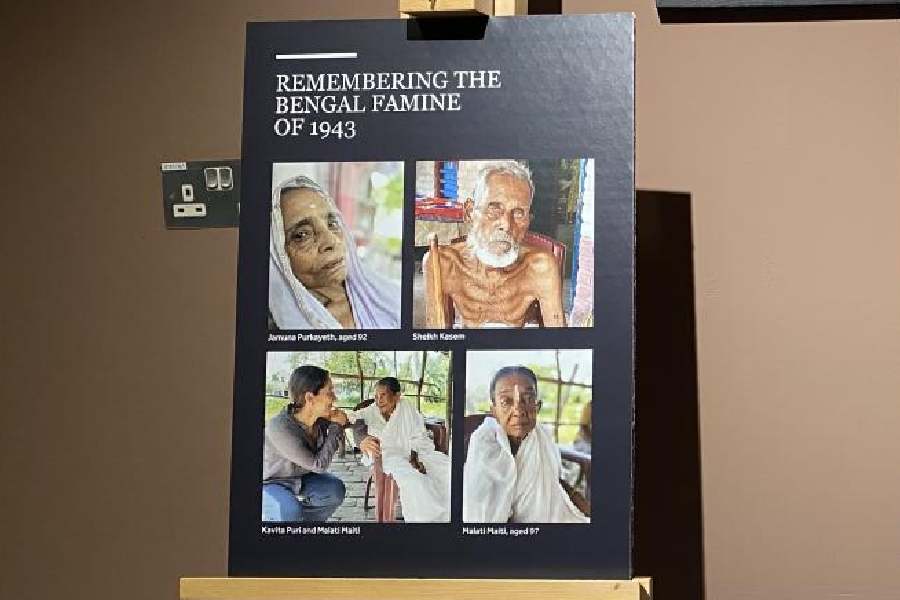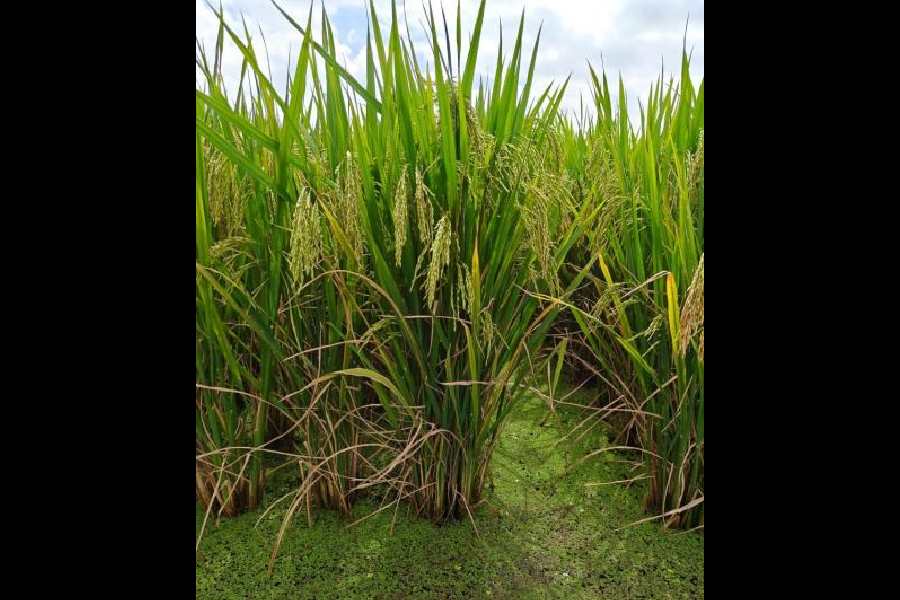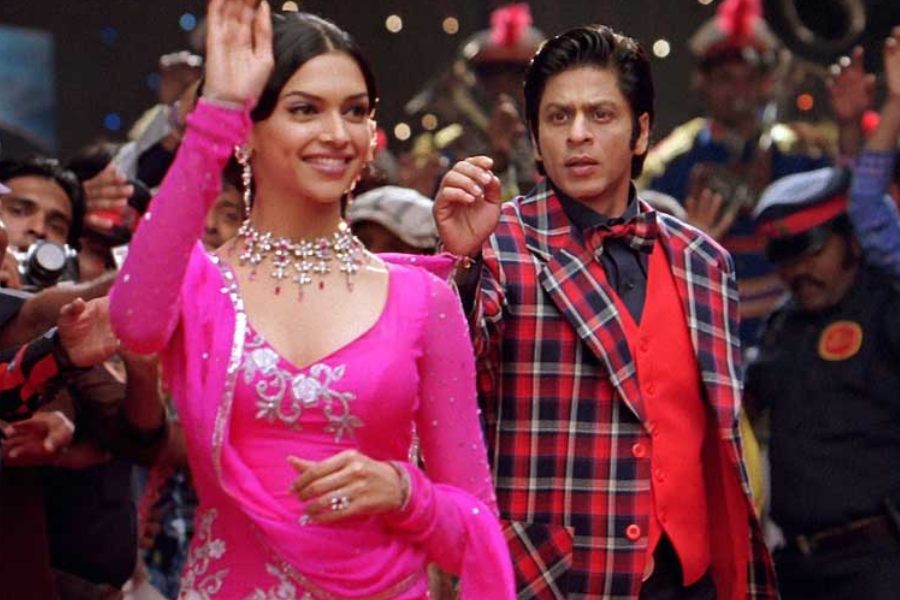 |
When the rain came down last week in Anechidri village, the first feeling that flooded through Sunandamma was disbelief. It hadn’t poured in these parts of Karnataka’s drought-stricken Chitradurga district for the past three years. So many times, the dark clouds had teasingly hovered above and so many times, proved only a broken monsoon promise.
So when she watched the fat drops of water falling on the hungry, red earth and then vanishing inside its parched belly, she, like other fellow villagers, couldn’t believe it was for real. But that was only for a fleeting moment. The rain almost immediately also reminded her of penury. The thatched roof, put together by joining several branches of the coconut palm, always leaked when it rained heavily.
But Sunandamma prefers the rains. There’s not much in her home the rains can destroy anyway. Not the cheap pictures of the smiling gods, or the few empty aluminium vessels piled in the kitchen, or her daughter’s glass bangles hanging by a thin rope. Of course, the wall clock may get wet. But, who cares, it doesn’t give the right time anyway. If it pours, the family of three can sit in the kitchen for some time. At least, that part doesn’t leak.
Drought brought privation. The rain promises blessings for the future. It means that nobody in the village has to work on the handpump for 20 minutes before the water emerges. And, it means in future everybody can have something better than ragi balls for brunch, the meal on which Sunandamma’s family subsisted for months.
“Before the drought, my husband cultivated groundnut, sunflower and jowar in our four-acre plot of land,” the middle-aged tribal woman dressed in a red, synthetic sari and green blouse tells the interpreter in Kannada. The rain means she can ask for some interest-free loan from the beedi seth and go back to tilling the land.
When the crops failed two years back, it set her back by Rs 6,000. Now she makes beedis. For every beedi she wraps, Sunandamma gets three paise. She is fast at her job. Wrapping around 1,000 beedis every day, the tribal woman makes about Rs 30. That’s how she has survived the drought.
Her husband is enthused by the rains. In the morning, he rushed to meet officials of the Scheduled Caste and Scheduled Tribe Corporation hoping to get a loan and get back to agriculture. If he gets that, she won’t have to ask the seth for money.
In this small roadside hamlet on the NH4 highway in Chitradurga district’s Iriyur taluk, most have similar tales of woe. It’s the sort of village where everyone is barefoot, where burnt wood is powdered to dust and used as tooth powder and where a meal of rice is a luxury one enjoys only at weddings. It is a village that often prayed for rain to deity Sineshwara, whose temple is one of the few cemented structures in the hamlet.
But even the gods failed to bring the relief officials to their door. “Can you help us?” Sunandamma asks as I put my notebook in the car and begin to leave. “I am just a newspaper reporter,” I say. Which means, I can’t. She smiles. I feel a strange guilt.
It’s the same story down the road in the Scheduled-Caste dominated Yerdakette village, about three kilometres off the highway. Iriyur is one of the better irrigated taluks in the district. But in the past three years, ponds have dried up and the coconut palms are close to dying. There are four-year-old children in this village who, like desert kids, have no memories of rain.
“The drought has turned farmers into coolies and labourers,” says Dayanand Girish, who sells coconut. Over the past couple of years, at least 50 villagers have left their homes and gone off to towns like Bangalore, about 180 kilometres away, or, up north to Bellary laying out telephone lines or lifting cement pipes to make a living. Ironically, they don’t want to work in the ongoing Golden Quadrilateral project much nearer.“You have to wait for 15 days for the payment,” says someone in the crowd.
The villagers want subsidy for the seeds and the electricity bill to be waived. The long drought may finally be coming to be an end but drought relief never came. The government had sanctioned a few quintals of rice for them but it never reached, thanks to corrupt officials. They read about it in Prajawani, the local newspaper. Before the elections, there was a story doing the rounds in these parts that so long as S.M. Krishna was the chief minister of the southern state, it wouldn’t rain. “Now, he is gone. And, see the rains have come,” says a villager who, like much of Chitradurga district, voted for the Congress anyway.
The villagers, though, have not broken into a rain dance, the sort of event which cosmopolitan five-star hotels manufacture at Rs 600 per couple, including snacks. Bearded Mohammed Sharif echoes a majority view when he says, the rain has given them no real reason to celebrate. “Let’s wait and see how the monsoon really shapes up,” he says. For them, the rain is no magic wand that will wipe out their daily misery.
At its best, the rain is a hyphen between happiness and despondency. If it pours hard over the next month or more, they can go back to tilling the land and sowing the seeds. Even, if it doesn’t, they say, there would still be some consolation. At least they won’t have to worry about the kuccha road that links their village to the highway being reduced to a slushy mud track. True, a few more men will migrate. And they will again huddle around the tea shop and discuss how the officials stole their foodgrain. But that’s in the regular order of things. Life goes on. It always has.










